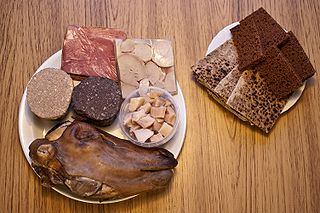
In cutlery or kitchenware, a fork is a utensil, now usually made of metal, whose long handle terminates in a head that branches into several narrow and often slightly curved tines with which one can spear foods either to hold them to cut with a knife or to lift them to the mouth.

A toaster is a small electric appliance that uses radiant heat to brown sliced bread into toast.

An open sandwich, also known as an open-face/open-faced sandwich, bread baser, bread platter or tartine, consists of a slice of bread or toast with one or more food items on top. It has half the amount of bread of a typical closed sandwich.
A spatula is a broad, flat, flexible blade used to mix, spread and lift material including foods, drugs, plaster and paints.

Bengali cuisine is the culinary style of Bengal, that comprises Bangladesh and the Indian states of West Bengal and Tripura. The cuisine has been shaped by the region's diverse history and climate. It is known for its varied use of flavours including mustard oil, as well as the spread of its confectioneries and desserts. There is a strong emphasis on rice as a staple, with fish traditionally the most common protein. Freshwater fish are preferred to seafish, although barramundi, known as bhetki, is also common. Meat is also a common protein among Bengalis with beef and goat meat being the most popular. In more recent times, lentils have begun to form a significant part of the diet. Many Bengali food traditions draw from social activities, such as adda, Eid feast or the Mezban.

The Etruria Works was a ceramics factory opened by Josiah Wedgwood in 1769 in a district of Stoke-on-Trent, Staffordshire, England, which he named Etruria. The factory ran for 180 years, as part of the wider Wedgwood business.

Kitchenware are the tools, utensils, appliances, dishes, and cookware used in food preparation, or the serving of food. Kitchenware can also be used in order to hold or store food before or after preparation.

Tableware items are the dishware and utensils used for setting a table, serving food, and dining. The term includes cutlery, glassware, serving dishes, serving utensils, and other items used for practical as well as decorative purposes. The quality, nature, variety and number of objects varies according to culture, religion, number of diners, cuisine and occasion. For example, Middle Eastern, Indian or Polynesian food culture and cuisine sometimes limits tableware to serving dishes, using bread or leaves as individual plates, and not infrequently without use of cutlery. Special occasions are usually reflected in higher quality tableware.

The Sterling and Francine Clark Art Institute, commonly referred to as the Clark, is an art museum and research institution located in Williamstown, Massachusetts, United States. Its collection consists of European and American paintings, sculpture, prints, drawings, photographs, and decorative arts from the fourteenth to the early twentieth century. The Clark, along with the Massachusetts Museum of Contemporary Art and the Williams College Museum of Art (WCMA), forms a trio of art museums in the Berkshires. The institute also serves as a center for research and higher learning. It is home to various research and academic programs, which include the Fellowship Program and the Williams College Graduate Program in the History of Art, as well as one of the most distinguished research libraries in the country, with more than 295,000 volumes in over 72 languages. The Clark is visited by 200,000 people a year, and offers many educational programs for visitors of all ages throughout the year.

Wedgwood is an English fine china, porcelain and luxury accessories manufacturer that was founded on 1 May 1759 by the potter and entrepreneur Josiah Wedgwood and was first incorporated in 1895 as Josiah Wedgwood and Sons Ltd. It was rapidly successful and was soon one of the largest manufacturers of Staffordshire pottery, "a firm that has done more to spread the knowledge and enhance the reputation of British ceramic art than any other manufacturer", exporting across Europe as far as Russia, and to the Americas. It was especially successful at producing fine earthenware and stoneware that were accepted as equivalent in quality to porcelain but were considerably cheaper.

Þorramatur is a selection of traditional Icelandic food, consisting mainly of meat and fish products cured in a traditional manner, cut into slices or pieces and served with rúgbrauð, butter and brennivín. Þorramatur is consumed during the Nordic month of Þorri (Thorri), in January and February, particularly at the mid-winter feast of Þorrablót (Thorrablot) as a tribute to old culture. Being thus connected with the tradition of Þorrablót festivals, Þorramatur is most often served as a buffet.

A kitchen scraper is a kitchen implement made of metal, plastics, wood, rubber or silicone rubber. In practice, one type of scraper is often interchanged with another or with a spatula for some of the various uses.

A kitchen utensil is a small hand-held tool used for food preparation. Common kitchen tasks include cutting food items to size, heating food on an open fire or on a stove, baking, grinding, mixing, blending, and measuring; different utensils are made for each task. A general purpose utensil such as a chef's knife may be used for a variety of foods; other kitchen utensils are highly specialized and may be used only in connection with preparation of a particular type of food, such as an egg separator or an apple corer. Some specialized utensils are used when an operation is to be repeated many times, or when the cook has limited dexterity or mobility. The number of utensils in a household kitchen varies with time and the style of cooking.

Black pudding is a distinct regional type of blood sausage originating in the United Kingdom and Ireland. It is made from pork or occasionally beef blood, with pork fat or beef suet, and a cereal, usually oatmeal, oat groats, or barley groats. The high proportion of cereal, along with the use of certain herbs such as pennyroyal, serves to distinguish black pudding from blood sausages eaten in other parts of the world.

Francine Clark (1876–1960) was a French actress, art collector, horse breeder, and philanthropist.

(Benton) Seymour Rabinovitch was a professor of chemistry at the University of Washington in Seattle, whose research including developing measurements for the efficiency with which energy is transferred between molecules in gas phase chemical reactions. Rabinovitch was an editor of the Annual Review of Physical Chemistry and of the Journal of the American Chemical Society.

Anne Tanqueray née Willaume (1691–1733) was an English silversmith, active from 1724–1733.
Elizabeth Morley was an English silversmith.

The fish knife together with fish fork represent a set of utensils specialized for eating fish. Fish knife is a strange-looking, purposedly blunt implement.



















